博文
分享一篇文章 SOX2 regulates acinar cell development
|
分享一篇文献,也是昨天在Journal Club上分享的。
关于SOX2蛋白—一种重要的胚胎干细胞调节蛋白。
SOX2 regulates acinar cell development in the salivary gland
Emmerson et al. eLife 2017; 6: e26620.
原文链接: https://elifesciences.org/articles/26620#fig2s1
作者简介: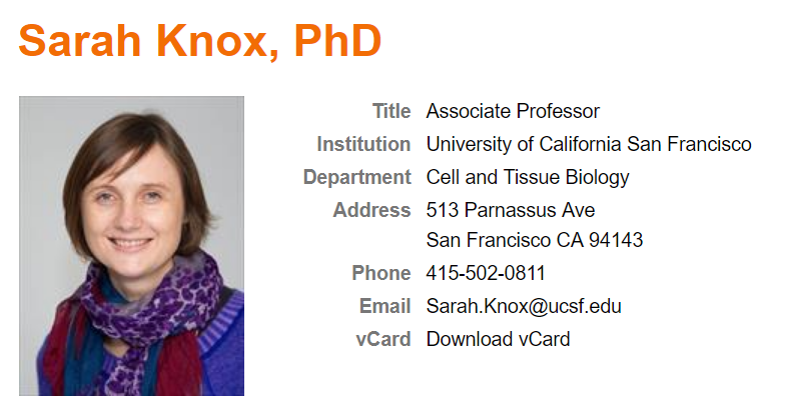 The Knox Lab is concerned with analyzing the cellular and molecular events underlying the formation of epithelial organs (organogenesis) and their regeneration after injury.
The Knox Lab is concerned with analyzing the cellular and molecular events underlying the formation of epithelial organs (organogenesis) and their regeneration after injury.
We employ multiple tissues (e.g. salivary gland, pancreas, ocular organs) to test three fundamental biological questions: 1) how do peripheral nerves impact epithelial stem cell fate decisions; 2) what are the mechanisms by which neuronal signals pattern organ architecture; and 3) how do immune cells modulate nerve-mediated morphogenesis, repair and regeneration. Understanding the relationships between multiple cell types will lead to new approaches to regenerate damaged tissue and to create new organs.
https://profiles.ucsf.edu/sarah.knox
这篇论文聚焦在SOX2蛋白在调节唾液腺salivary glands发育中的作用。
首先介绍一下salivary glands:
The salivary glands produce fluid that contains enzymes to help us to digest our food.


salivary glands的分布和类型(Images form Wikipedia)

The localization of the three major salivary glands in humans (A) and mice (B)
是的,salivary glands很重要,但是对于acinar cells 在器官发育过程中的发生机制一直不清晰。
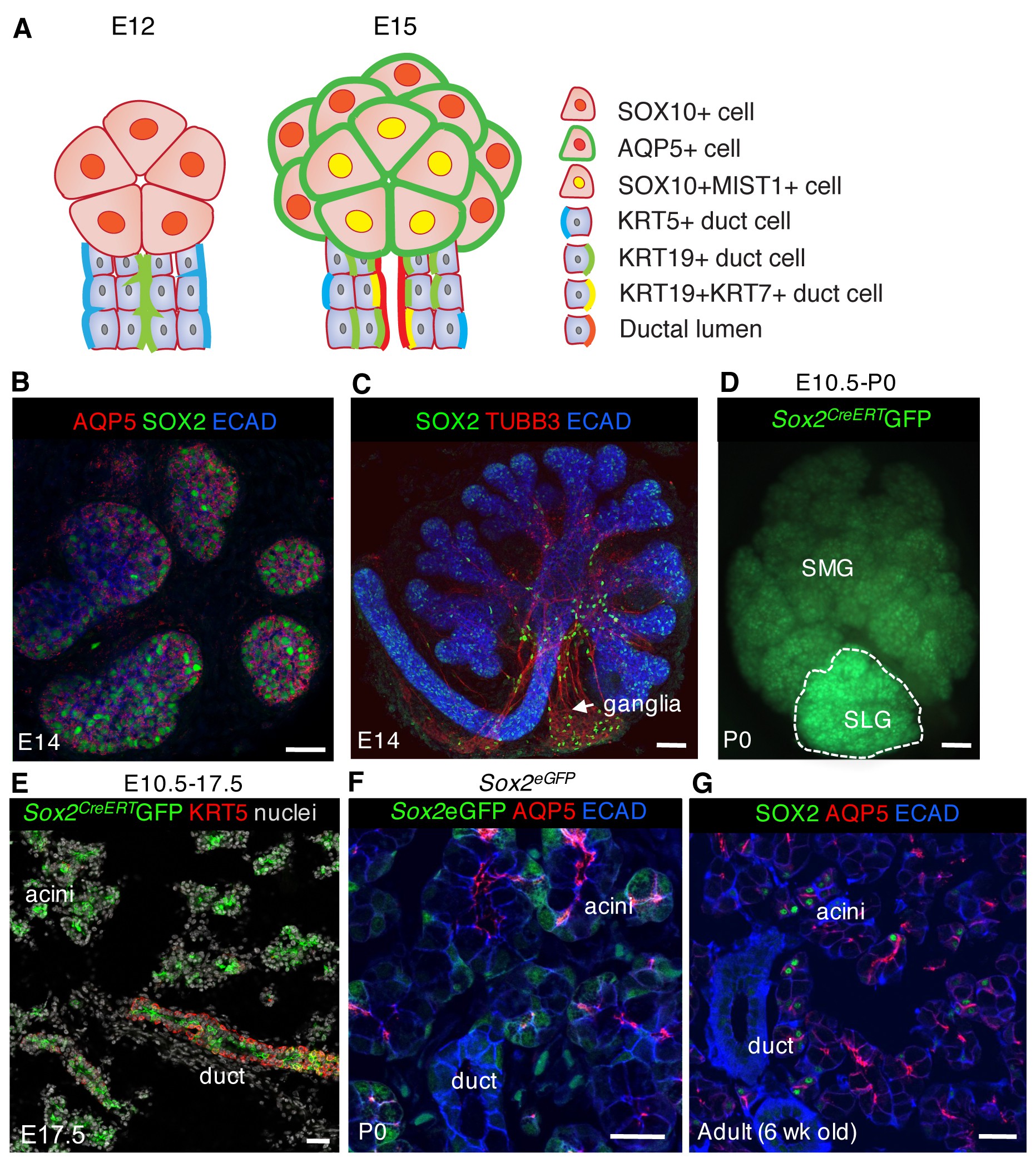 图A显示了很多标记不同细胞类型的markers,源于他们之前大量的工作。
图A显示了很多标记不同细胞类型的markers,源于他们之前大量的工作。
SOX10+标记未分化的acinar祖细胞,AQP5+和MIST+标记分化了的acinar细胞;KRT5+和KRT19+/KRT7+分布标记未分化和分化了的ductal cells;
B-G主要显示了SOX2蛋白的定位
1. SOX2 is expressed by the epithelium of the SLG and the proximal duct of the SMG and the developing parasympathetic ganglion. (Figure 1C)
2. Genetic lineage tracing indicated that SOX2-positive cells are progenitors giving rise to both duct and acinar cells of the SMG and SLG. (Figure 1D, E)
3. However, SOX2 becomes restricted to a subpopulation of AQP5+ acinar cells in the postnatal and adult SLG. (Figure 1F and G)
SOX2 might function in the expansion and/ormaintenance of the acinar lineage.
这个数据显示SOX2可能在acinar lineage的扩张和维持发挥作用。
然而,SOX2在是如何发挥作用的呢?
1. The number of end buds in the SMG and SLG was significantly reduced, even the SLG exhibited little to no branching. (Figure 2A–B).
2. The number of SOX10-positive progenitors and differentiated AQP5-positive and MIST1-positive acinar cells were severely reduced. (Figure 2C-E)
3. Moreover, RNA-seq and qPCR validation confirmed the reduction in genes associated with differentiated acinar cells (Smgc, Pip, Spdef, Rab3d;Figure 2C)
4. Conversely, duct morphology, the number of ductal cells and ductal gene transcripts (Krt7, Krt19 and Egfr) which are required for ductal were similar to controls (Figure 2A–D).
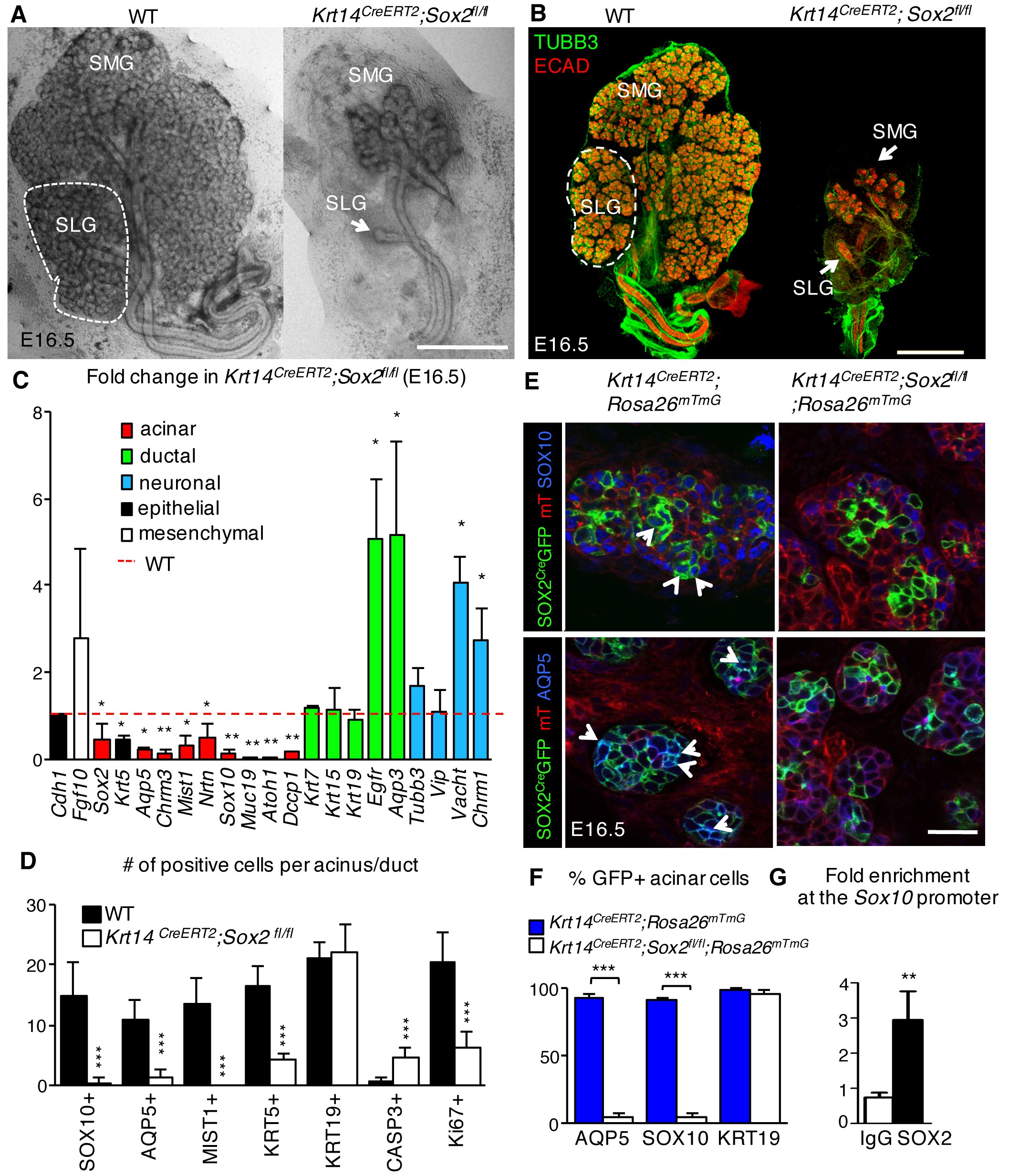
5. In Figure 2E, SOX2 co-localizes with the acinar progenitor marker SOX10 and SOX10 expression was lost upon ablation of Sox2. Then they determined that SOX10 was specifically lost in Sox2-ablated cells using a lineage-tracing model. ChIP-qPCR analysis indicated that SOX2 significantly enrichment at the Sox10 promoter suggesting that SOX2 could directly regulate Sox10 via transcriptional control of Sox10.
SOX2敲除之后,SMG+SLG end buds、acini祖细胞及分化细胞数量和acinar cells相关的基因都出现了显著的reduction;相反地,却对duct没有任何影响。
他们还发现了SOX2可以直接调控SOX10的转录来发挥作用。
那么问题来了,SOX2缺失是如何造成细胞减少的?
他们首先测定了cell fate,因为在其他器官的研究中发现,SOX2确实会造成细胞命运的改变,分化成其他的细胞,比如in the pituitary, loss of SOX2 expression in progenitors leads to melanotrophs transform to corticotrophs.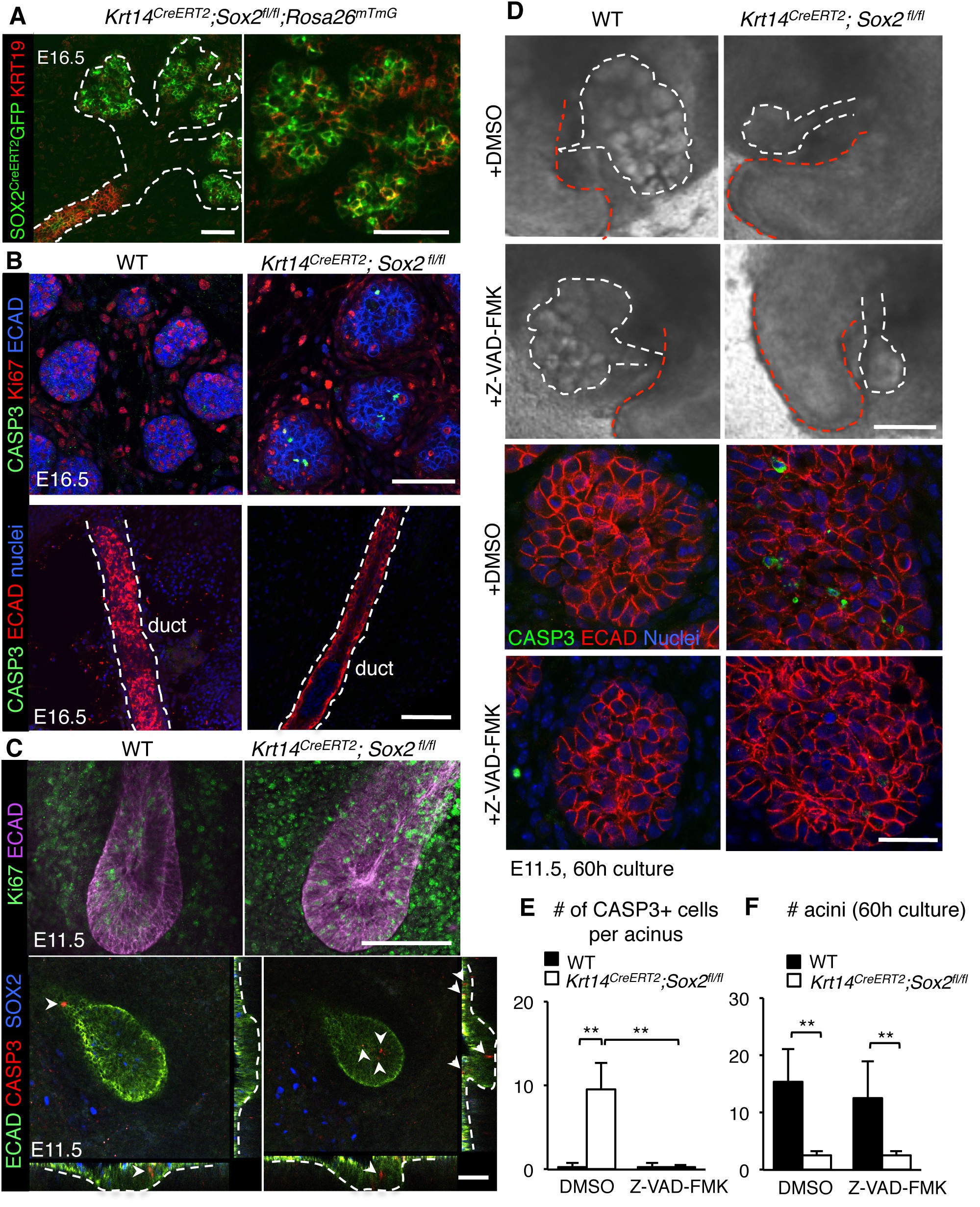
However, they did not find any evidence that Sox2-deficient cells in the end buds divert toward a duct cell fate (Figure 3A, GFP+ cells 没有表达 early ductal marker KRT19).
所以,他们检测了细胞凋亡。
In the absence of Sox2, there were activated Caspase-3-positive cells in the end buds (Figures 2D and 3B) and increased expression of pro-apoptotic genes (Bax, Bbc3 and Pmaip1); But no apoptosis was observed in the ducts (Figure 3B), suggesting a preferential requirement for SOX2 in end bud cell survival.
In addition, the proliferation of end bud cells was decreased ~70% in salivary glands lacking Sox2 (Figures 2D and 3B; Ki67+ cells);在SOX2缺失情况下,凋亡基因Caspase-3在end buds被激活,凋亡相关基因表达量升高,细胞增殖减少;但是对duct没有影响。可见SOX2对于end buds存活是必须的。
接着,他们抑制了凋亡来看是否能够拯救acinal cells。通过在离体培养的Sox2-deficient embryos ex vivo中加入
pan-caspase inhibitor Z-VAD-FMK,the results shown a significant reduction in CASP3+ cells, extensive cell survival and growth of the epithelium, however, no an increase in the number of acini in Sox2-deficient SMG+SLG cultured with the cell death inhibitor. (Figure 3D–F).
可见抑制凋亡拯救了acinal cells存活和增殖,Thus, these data reveal novel, independent roles for SOX2 in regulating epithelial cell survival and generating acini.
前人的研究表明,外周神经能够通过acetylcholine/muscarinic activation使KRT5+祖细胞维持在未分化状态,是否外周神经能控制SOX2+ progenitor cells?
1. By comparing SG where the ganglia-ablated with nerve-containing controls, we can find a severe reduction in the number of acini, SOX2 protein and SOX2+ cells. And the acinar lineage was also greatly depleted. In the ganglia-free SG, we aslo found a significant reduction in SOX10-positive acinar progenitors and differentiated AQP5-positive acinar cells compared to controls. (Figure 4A–C)
2. Similarly, acini, SOX10+ cells, Sox2 and acinar gene expression were reduced in SMG+SLG derived from Phox2b mutant embryos that are deficient in the submandibular parasympathetic ganglion and other craniofacial ganglia. (Figure 4D–F)
3. However, absence of innervation did not impair the expression of ductal marker KRT19 or ductal gene transcripts (Figure 4A and F).
Thus, Parasympathetic nerves selectively preserves those progenitors that contribute specifically to the acinar cell lineage.
可见,神经对于acinar cell lineage祖细胞的维持起着重要的作用。So, 神经是怎样发挥作用的呢?
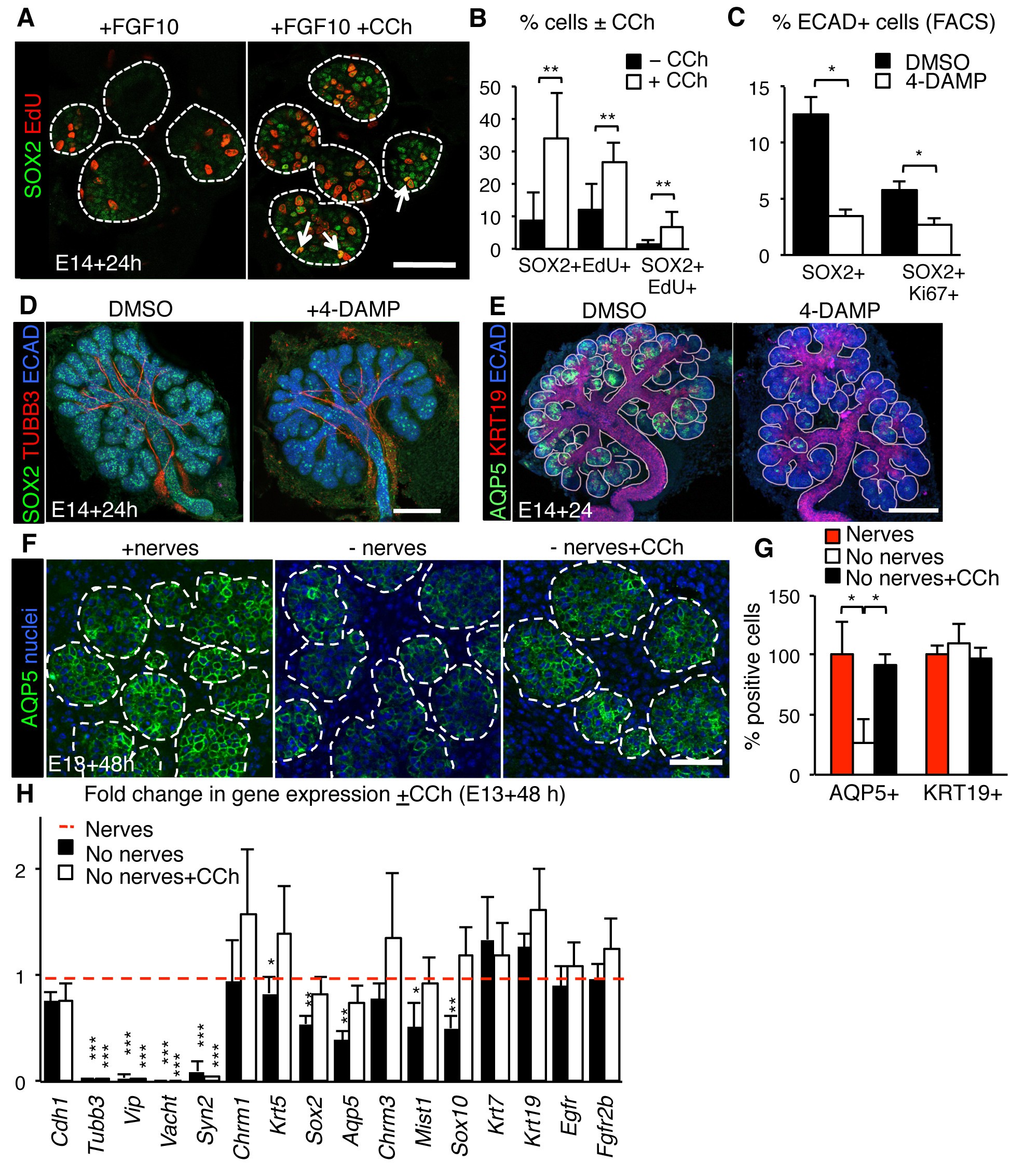
FACS analysis showed that 94% of the SOX2-positive epithelial cells in the SLG at E15.0 express the muscarinic receptor CHRM1, 说明CHRM1 activation是潜在的调控因子。
为了检测CHRM1是否直接作用于SOX2,
1.他们在离体培养的无神经的上皮组织中加入CHRM1兴奋剂carbachol (CCh)检测到increased the number of SOX2+ cells as well as proliferating SOX2+EdU+ cells compared to the control.(Figure 5A–B)
2. 添加muscarinic抑制剂4-DAMP 结果发现 reduced SOX2 expression (gene and protein), the number of SOX2+ cells and SOX2+ cell proliferation. (Figure 5C–D)
3. Also, inhibition of CHRM1 decreased end bud cell proliferation, differentiated AQP5-positive acinar cells and SOX10-positive acinar progenitors.
4. Whereas KRT19-positive cells (Figure 5E) or ductal lineage transcript levels were unchanged (Krt7) or increased (Krt19 and Egfr).
进一步探究CCH是否能够回复去除神经之后的上皮组织原来的表型,他们添加CCH到nerve-free SMG+SLG explants (containing mesenchyme)发现CCH有效地恢复了SOX2的表达,AQP+cells的数量以及scinar cells相关的转录本的水平。因此,可以说CHRM1调控SOX2,是acinar lineage发生所必须的。
最后他们在人的fetal SLG explants中重复了以上实验,并得到了类似的结果,这说明从老鼠到人,SOX2在acinar linneage发育中的作用是保守的。

总结一下:
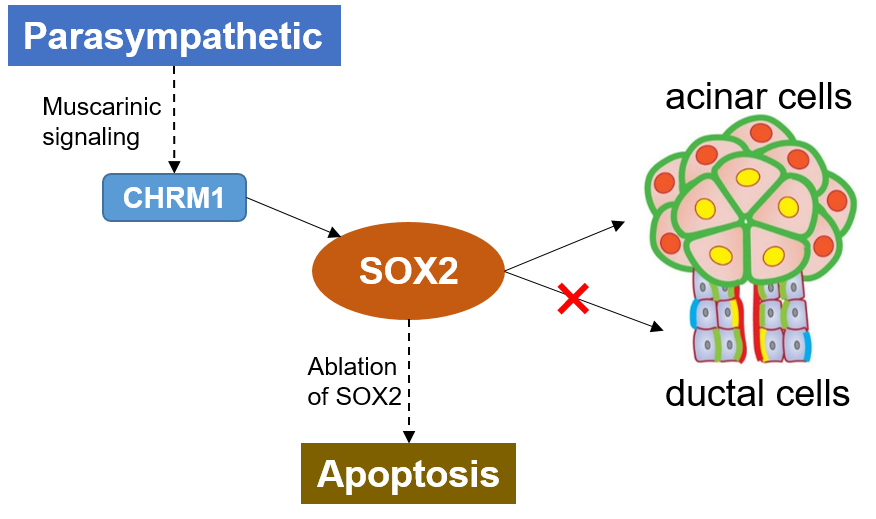
这篇文章很全面系统的研究了SOX2在acinar cell lineage发育中的作用,逻辑清晰,证据充分,围绕着一个点展开研究,是一篇值得细读的文章。
WZQ20181115-Journal Club-SOX2.pdf
https://blog.sciencenet.cn/blog-3392387-1146582.html
上一篇:如何读好一篇文献 ——《文献深度分析讨论课程》感想